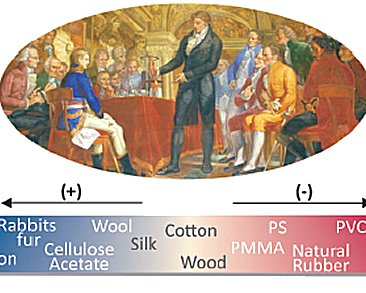Since the times of Volta, scientists have strived to construct the so-called triboelectric series (TES) that would rank the contact-charging properties of various materials (pictured). For contacting metals such ranking has been relatively straightforward. The construction of a robust TES for bulk dielectrics has proven surprisingly challenging. The literature on the subject has been marred with irreproducible results, including situations where different polarities of charge have been reported by different laboratories for supposedly the same contact-charged materials.
Bartosz A. Grzybowski, Northwestern University, Evanston, IL, USA, and colleagues show that contact charging of dielectrics cannot be predicted solely on the basis of their bulk properties. Instead, it is necessary to account for the transfer of minute amounts of material (ca. 1 µg/cm2) between the contacting surfaces. Material transfer can lead to such counterintuitive phenomena as the reversal of charge polarity during contact charging, and is related to the differences in the mechanical properties of the contacting dielectrics.
Future studies on contact charging should take into account the molecular and nanoscale mechanics and the corresponding changes in the structure of materials. Only with such a microscopic understanding at hand, will it be possible to construct a truly coherent and predictive triboelectric series.
- Material Transfer and Polarity Reversal in Contact Charging,
H. Tarik Baytekin, Bilge Baytekin, Jared T. Incorvati, Bartosz A. Grzybowski,
Angew. Chem. Int. Ed. 2012, 51.
DOI: 10.1002/anie.201200057




